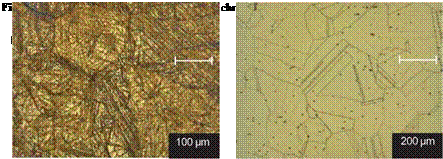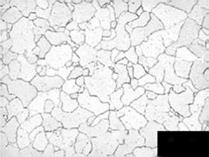Non-rusting Chrome Steels
Non-corrosion steels are distinguished by good resistance to chemically aggressive substances. In general, they have a chrome content of > 12 %. Non-rusting steels can be subdivided with respect to their structural components into ferritic and martensitic as well as into austenitic steels.
Martensitic chrome steels contain about 0.4 — 1.2 % C and 12 — 18 % Cr. They are primarily utilised as knife steels in the cutlery industry as well as for machine components that simultaneously require high amounts of hardness, wear and corrosion strength.
Steels with < 0.1 % C and > 16 % Cr belong to the non-rusting ferritic chrome steels. The chrome content can increase up to 30 %. In order to improve the corrosion resistance, these steels contain up to 2 % Mo. The basic type of this steel
group is steel X7Cr17, which is utilised in an annealed state. Its structure consists of ferrite and carbide.
 |
 In non-rusting austenitic chrome-nickel steels, the range of the face-centred cubic austenite lattice is extended for room temperature and under by adding austenite-forming elements, basically nickel. Due to their properties, these steels are of the greatest importance within the non-rusting steel group. Steel X5CrNi18 10 should be considered the basic type. The austenites exhibit a strong inclination toward cold forming. Micrograms of chrome steels with various microstructures are shown in Fig. 4-11.
In non-rusting austenitic chrome-nickel steels, the range of the face-centred cubic austenite lattice is extended for room temperature and under by adding austenite-forming elements, basically nickel. Due to their properties, these steels are of the greatest importance within the non-rusting steel group. Steel X5CrNi18 10 should be considered the basic type. The austenites exhibit a strong inclination toward cold forming. Micrograms of chrome steels with various microstructures are shown in Fig. 4-11.
Fireproof Steels
What fireproof steel materials mainly have to offer is sufficient resistance against hot gas corrosion at temperatures over 550 °С. Besides ferritic steels, austenitic steels with chrome and nickel (to further increase heat resistance) are employed.
High-temperature Steels
High-temperature steels exhibit favourable mechanical properties and high longtime rupture strengths under long-term strain at high temperatures (up to 800°C). The 12 % Cr steel group also belongs to these steels. Steels with 16 -18 % Cr and 10 — 13 % Ni, whose austenitic structure exhibits a higher resistance to form — alteration at high temperatures, are more highly heat-resistant.
Austenitic manganese steel, for example, consists of metastable austenite (soft and ductile) at room temperature. During machining, the austenite transforms into stable martensite. This transformation causes hardening in the area of the cutting zone.
